Hydrangea paniculata Little Lime - planting and care
The Dutch hydrangea Little Lime is a sport of the lime light variety and is better known by the name Jane. A perennial ornamental shrub was developed in 2005. The plant has increased frost resistance, therefore it is suitable for growing in all regions of our country. Consider its characteristics, planting and care rules.
- Description of the plant
- Landing rules
- Timing
- Place and soil
- Preparation of planting material
- Landing technique
- Care
- Watering
- Top dressing
- Pruning
- Leaving during flowering
- Post-flowering care
- Preparing for winter
- Reproduction methods
- Cuttings
- By dividing the bush
- Diseases and pests
- Powdery mildew
- Rust
- Gray rot
- Aphid
- Slugs
- How to decorate a plot
- Testimonials
- Useful videos
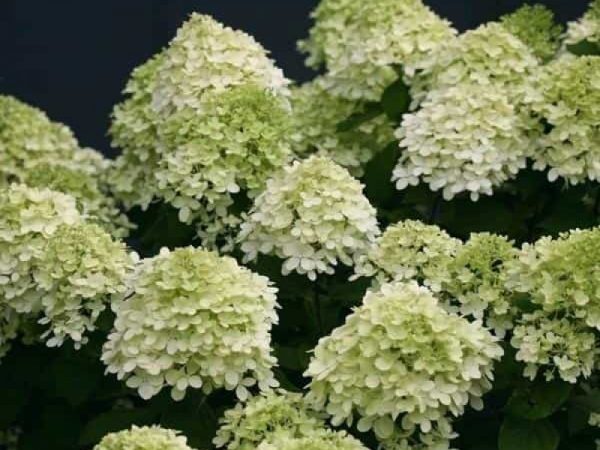
Little lime hydrangea paniculata
Description of the plant
The scientific name is hydrangea paniculata little lime. Hydrangea blooms in mid or late July, blooms in November. Possesses high frost resistance - it can withstand temperatures down to -34 ° С. Therefore, only young bushes need shelter, they are not insulated with age.
The plant has a slow growth rate - in a year, the shoots stretch 7-8 cm in length. The root system is well developed, branched, located close to the surface of the earth.
External parameters:
- compact crown - from 90 to 120 cm;
- diameter - 1.5 m;
- stems are dark red, erect, rigid, do not bend to the ground under the weight of large buds;
- inflorescences panicle-shaped, cone-shaped, large - height 13 cm, circumference 10 cm;
- emerald leaves, elongated with a pointed end;
At the beginning of flowering, the flowers are pale green or snow-white, later they acquire a light pink tone, and closer to autumn, a burgundy hue.
Landing rules
Timing
The best time to plant seedlings is mid or late April. Such terms are suitable for regions with a continental and harsh climate.
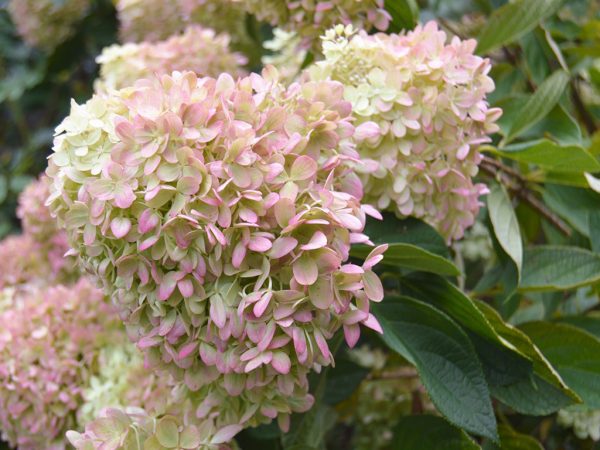
Hydrangea paniculata little lime
In the south, in the Middle Lane, where the summer is long and the autumn is warm, the bushes are planted in spring and autumn. But this must be done before the end of September, so that the seedlings have time to take root and prepare for the upcoming wintering.
Place and soil
Prefers to grow in light shade, where there is access to the sun in the morning and evening, and shade in the afternoon.
You can plant bushes near tall trees, bushes, which will create shade at lunchtime. You can also plant it at a distance of 50-60 cm from the walls of a house, fence or outbuilding.
Choose a windless area with a deep passage of groundwater - up to 2 m.
It grows well on loamy soil enriched with organic and mineral components with an acidic or slightly acidic reaction. Before planting on clay soil, you need to ensure good drainage - sprinkle with 20 kg of sand, perlite or vermiculite per 1 m². Then dig and level.
Preparation of planting material
If you want to grow a shrub with all the varietal characteristics, you should go to buy a seedling in a horticultural nursery or specialty store.
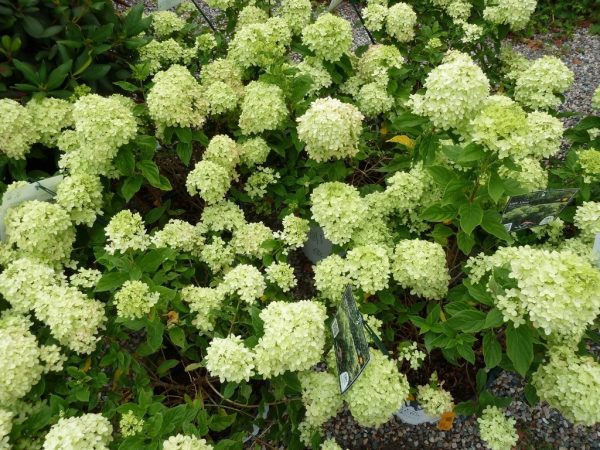
Hydrangea little lime planting and care
Choose 2- or 3-year old specimens with a well-developed aerial part and root system. It is better to take bushes in an earthen coma or planted in containers. So their roots will not dry out until they are planted on the site, like in plants with open roots.
In healthy seedlings, the crown is fresh, the leaves do not crumble, and the shoots are flexible, without cracks, breaks and growths. Buds and leaves are juicy, green, without yellow, brown and black spots, inclusions.
Before planting, the seedlings are removed from the store container, dipped in cold water for a couple of hours, then the roots are cut to 2-3 cm in length. This will stimulate the rapid establishment and growth of new shoots.
Landing technique
The pits are prepared in advance - 2 weeks in advance. So the nutrients and drainage embedded in them will have time to settle. The optimal distance between them is 1.5 m.The approximate dimensions are 60x60x70 cm.
At a third of the depth, they are filled with a mixture of pebbles, crushed stone, screenings and brick chips. Then it is half filled with a fertile composition of compost, peat, sand and leafy earth, mixed in a ratio of 2: 1: 1: 2.
The soil mixture is crushed, a hole is pulled out in the center, the seedling is lowered into it so that the root collar remains on the surface of the soil. In the near-trunk zone, they trample, moisten, mulch with a thick layer of peat, compost or sawdust to prevent rapid evaporation of moisture.
Care
It is not difficult to care for the little lime panicle hydrangea, the main thing is to carry out all the necessary measures on time and correctly.
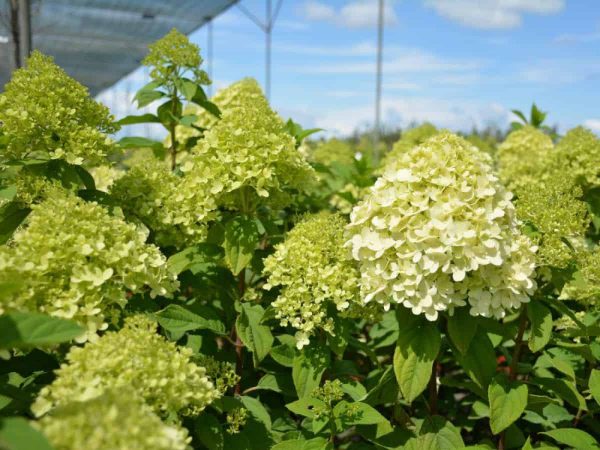
Hydrangea little lime care
In the first two weeks, the bushes need protection from the scorching sun - at lunchtime they are shaded with burlap or agrofibre.
Watering
For a month, the seedlings are hydrated every day to help them take root and grow faster. A bucket of water is poured under one bush.
Further, watering is reduced and carried out as the soil dries to a depth of 5-6 cm. If the summer is rainy, you do not need to water, otherwise the bushes will quickly rot from excess moisture.
Adult shrubs from three years of age additionally moisturize in early spring, a week before budding, after flowering ends, and in autumn, when the hydrangea sheds foliage.
Use warm and settled water at room temperature to prevent hypothermia of the rhizome.
After watering, the soil in the near-trunk zone is loosened, so it retains moisture and breathable qualities. In order to prevent the appearance of pests, weeds are regularly removed, weeded between seedlings. To protect the soil and roots from drying out, add sawdust or peat mulch.
Top dressing
Without quality and balanced nutrition, Little Lime Hydrangea will grow slowly and bloom sparsely. Therefore, in the third year of cultivation, they begin to fertilize it annually and several times per season:
- In early spring, before the blooming of vegetative buds, the near-stem circle is spilled with liquid nitrogen-containing fertilizer. 15 g of nitrophoska, ammonium nitrate or urea are dissolved in 10 liters of water. 5 liters of solution are poured under one bush.
- Before the formation of buds, they are watered with a mineral composition - mixed in 1 tbsp. l. superphosphate and potassium sulfate, diluted in a bucket of water. Consumption - 5 liters per seedling.
- The same feeding is fed after the end of flowering.
- In the fall, when the plant fades and leaves the foliage in the near-trunk circle, compost or last year's manure is covered up - 10 kg of substance per 1 m².
To speed up the process of assimilation of nutrients and prevent burning of the roots, after fertilization, the bushes are watered abundantly.
Pruning
Immediately after planting, the tips of the shoots are pinched in order to stimulate the growth of a young growth. This plant does not need to form a crown - as it grows, only those branches that thicken the aerial part or grow at the wrong angle need to be removed.
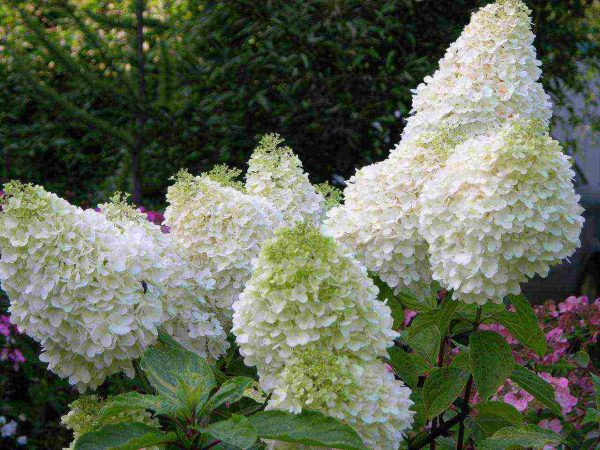
Hydrangea paniculata hydrangea paniculata little lime
Also cut out all the places that are frozen, dry, damaged by wind or disease. The remaining strong branches are shortened to the third bud.
These manipulations are carried out in early spring and late autumn. Use a sterile and well-sharpened instrument. For quick recovery and prevention of infection with infections after cutting, the crown is irrigated with a solution of copper sulfate.
Leaving during flowering
At the peak of decorativeness, watering is reduced, and fertilizing is completely eliminated, which allows you to extend the flowering period. It is also necessary to promptly remove all inflorescences that have dried out.
Additionally, small and loose buds should be cut off so that the plant does not waste energy on their development, but puts all the energy into the formation and blooming of large flowers.
Post-flowering care
To restore strength, the shrub is abundantly watered and fed with the above fertilizer. They also cut out all the buds that have dried up, since they take away all of his energy.
Preparing for winter
An adult hydrangea has good resistance to severe frosts, but up to three years from the moment of planting it needs high-quality insulation.
This procedure is started in the fall, a week before the upcoming cold weather:
- the near-trunk zone is treated with slaked lime to avoid the appearance of infections and pests;
- spud with a thick layer of peat or sawdust - 15 cm;
- twigs are tied with a rope in a bundle, then wrapped in burlap or covered with spruce branches.
The insulating material is removed in the spring, when the snow thaws and the last frosts pass.
Reproduction methods
There are two effective methods of propagation of perennial shrubs that gardeners use. Subject to all the rules of harvesting, planting and care, you can grow strong varietal seedlings.
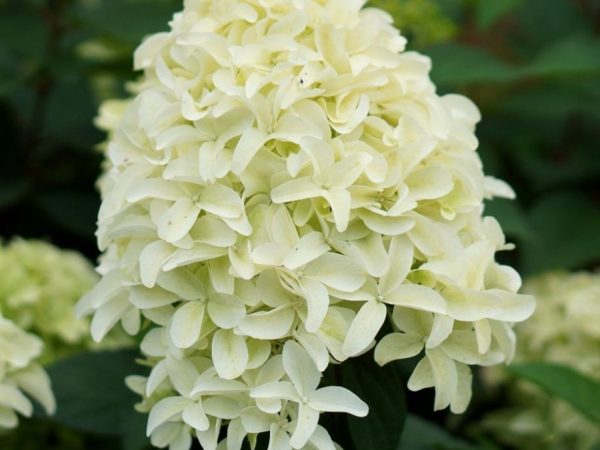
Hydrangea paniculata little lime planting and care
Cuttings
Cuttings are done in spring or summer. The apical shoots of the current year with green bark are used. Cut at a height of 20 cm with two internodes, several buds and leaves.
In the lower part, the foliage is completely removed, the top is cut to half the length. Dip into one of the root formation stimulants for an hour. Then they are planted in a wet mixture of peat, leafy earth and sand (1: 2: 1). The depth of the cuttings is 3-4 cm.
The plantings are moistened with warm water, covered with a film, placed in a warm and well-lit place.
For 2-3 weeks, they are ventilated every day, if necessary, watered. If everything is done correctly, after this time they will release roots and new leaves. Then the shelter is removed, grown for another month so that they are overgrown with roots, then transplanted into open ground in the same way as purchased seedlings.
By dividing the bush
Little lime dwarf hydrangea is successfully propagated by dividing the rhizome. This method is used for old bushes that need to be rejuvenated or for plants with damaged roots and diseases.
The technology consists of several stages:
- in spring, when the heat outside stabilizes, the bush is abundantly moisturized;
- an hour later, when the earth gets wet, they dig out, lower the roots into a container of water to wash off the remnants of the soil;
- the rhizome is dried, divided with a shovel or knife into parts, so that each delenka has several roots and at least one shoot with green buds;
- the places of the cuts are sprinkled with charcoal, then they are seated separately in the garden.
If the root system is rotten, you must first cut out all the rot, put it in a fungicide solution for an hour, and dry it. Then everything is done according to the technology described above.
Seed propagation is little practiced in private gardening, since hydrangea seeds have poor germination, and only a small number of seedlings survive until the moment they are transplanted to the site.
Diseases and pests
Like other varieties of panicle hydrangea, this variety has good disease and parasite resistance.Infection is possible only in case of violation of the rules of care and maintenance.

Hydrangea little lime photo
Powdery mildew
Fungal infection appears in wet and rainy weather, manifests itself in the form of a white oily coating on the leaves, inflorescences. Over time, the affected areas darken and die off.
The treatment is as follows - the diseased parts are cut out, then the crown is irrigated with fungicides - Topaz, Skor or Hom.
Rust
It mainly affects shrubs growing in weed thickets and in thickened areas. Signs - red or brown shapeless growths on leaves, shoots. After a while, the foliage turns yellow, crumbles, the plant stops growing and stops blooming.
To destroy a fungal infection, it is necessary to treat the crown with Bordeaux liquid or Ridomil gold.
Gray rot
The infection is caused by frequent overflows of cold water. Brown spots with a bluish bloom appear on the foliage. First, the infected areas are removed, then the bush is treated with an Azocene solution or copper sulfate.
Aphid
It feeds on the sap of the leaves, which leads to their wrinkling, yellowing, drying out and falling off. In a short time, the bush can become bald and die.
In the fight against the parasite, several drugs are used - Akarin, Karbofos or Fitoverm.
Slugs
They eat out the foliage, leaving only streaks. In the fight against pests, pesticides are used - Slug-Eater or Thunderstorm. In order to avoid re-invasion, the tree-trunk circle is sprinkled with wood ash or coniferous sawdust.
For prevention, it is recommended to perform a number of simple measures - to buy healthy seedlings, avoid thickening during planting, loosen the soil in time, remove weeds, cut out non-viable stems, flowers and leaves, water and feed regularly.
How to decorate a plot
The bright and lushly blooming Little Lime hydrangea is readily used in modern landscape design:
- planted singly or in groups along fences, in alleys;
- combine with other varieties to create a multi-colored composition both in the center of the garden and in its remote places;
- combined with decorative perennials - roses, azaleas, rhododendrons;
- planted near terraces, gazebos, benches, used in the creation of bright mixborders.
Testimonials
Most gardeners give a positive characteristic to the Little Lime variety:
- does not need shaping, but warming with mature age, which greatly facilitates the care of the shrub;
- with good care, the content is practically not damaged by diseases and pests, therefore there is no need to use pesticides;
- successfully reproduces, which makes it possible to independently grow varietal seedlings.

